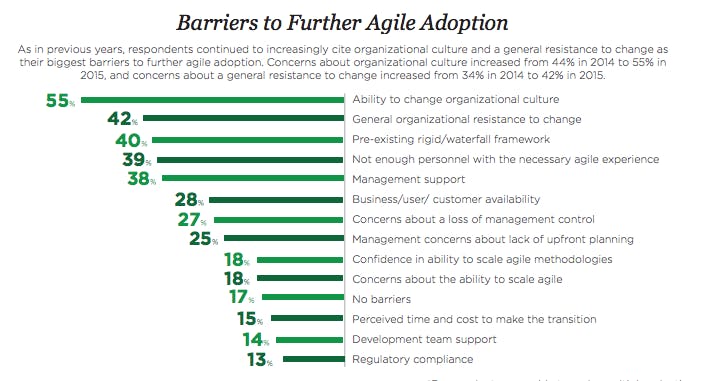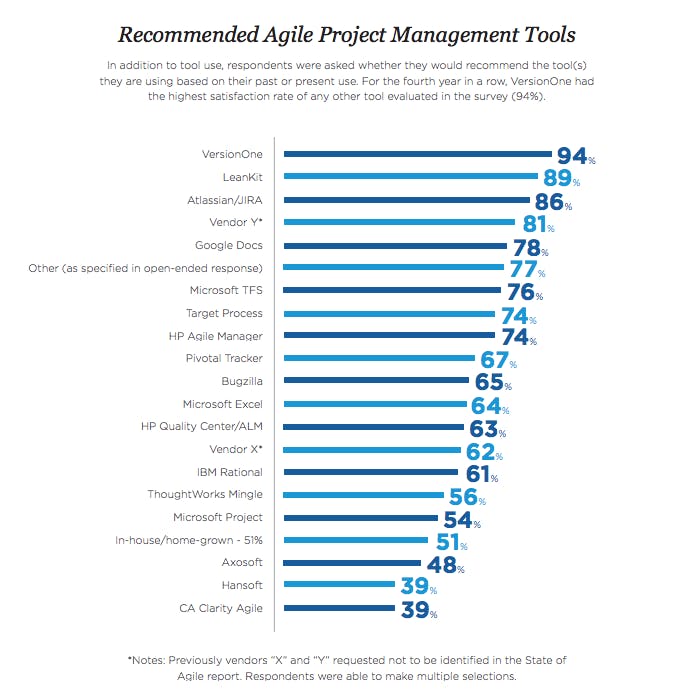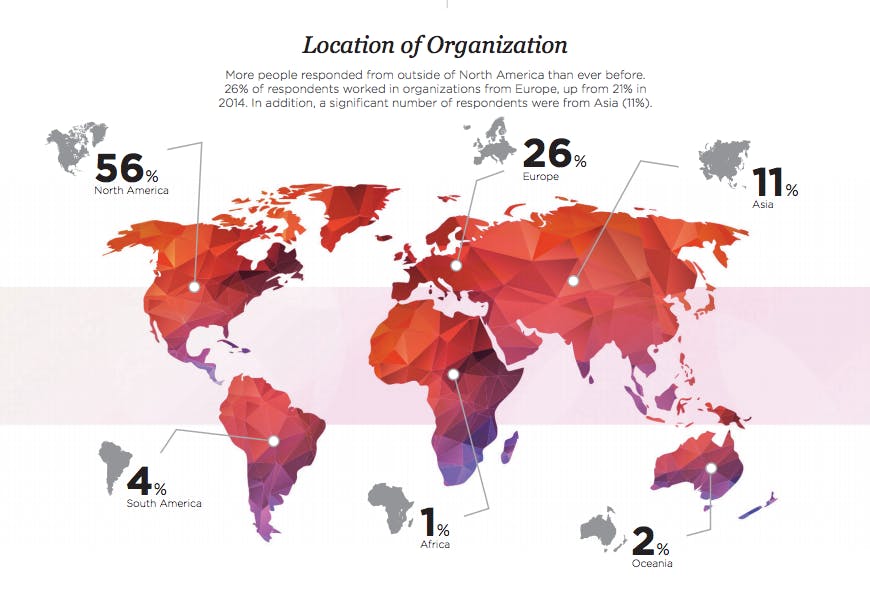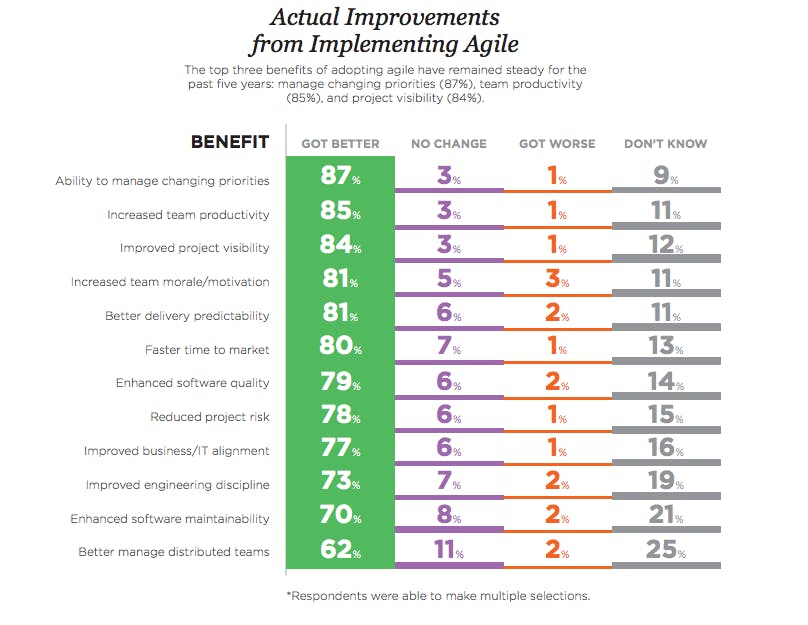It’s been 15 years since the Agile Manifesto was created and the software development methodology is still one of the most practiced around the world.
With the release of the 10th Annual State of Agile™ Report from VersionOne®, we can get a good sense of where Agile teams and the businesses who use them stand in 2016. This is a survey of global scale, as indicated by the demographics at the end of this post, so it definitely applies wherever you are.
Why Do Companies Adopt Agile?
Businesses tend to adopt Agile because Agile places a focus on speeding up the product delivery process by allowing teams to be more productive while also giving a better way to manage priorities. According to the survey, businesses have found that using Agile in software development has created a higher quality product for clients. Overall, the businesses who implemented Agile experienced many benefits.
How Do Teams Execute Agile?
Scrum is still the most popular way to practice Agile, with 58% of respondents indicating they use this method. The next, with only 10% of teams trying it out, is the Scrum/XP (Extreme Programming) method; the XP method varies only slightly from Scrum, with shorter sprints (one week), a more stringent adherence to priority order and a focus on using engineering practices. Next, the most practiced methods by teams were a Custom Hybrid of multiple methodologies (8%) and Scrumban (7%), a combination of Scrum and Kanban.
Learn More About Agile
What Are the Top 5 Agile Techniques?
According to the State of Agile report, of the many techniques that teams use, many find the daily standup, prioritized backlogs, short iterations, retrospectives and iteration planning to be the best way to accomplish goals. VersionOne noted that iteration planning has fallen by a couple of percentage points and it may be a result of transitioning to methods like Lean and Kanban, a straight, more flow-based method.

Why Do Agile Projects Fail?
In a perfect world, Agile projects would always succeed. But in businesses where change is slow to happen, Agile can shake up things a bit too much. The problem that most respondents faced was a company philosophy or culture at odds with core Agile values (46%). This is often the result of management that is not responsive to learning about Agile or its benefits, with 38% of respondents noting the lack of management support. There were many other barriers to Agile adoption, including:

How Do You Scale Agile?
If you have the opposite problem, and your large company is jumping at the chance to scale Agile into many departments, there are successful ways to do that. The top method, which 72% of respondents have tried is a Scrum of Scrums.

What Are the Best Agile Tools?
Finally, we come to the best tools to execute Agile. Since VersionOne is an Agile platform, we know that they will recommend themselves as a must-have tool. When ranked, VersionOne took fourth place, with 28% of respondents using their platform. Surprisingly, the top tool used by 60% of respondents is plain old Microsoft Excel. Three Microsoft products ranked in the top five, not necessarily because they were the best, but most likely because most businesses already own many of the Microsoft products, like Excel. The next tools on the list were Atlassian/JIRA at 51%, Microsoft Project at 33% and Microsoft TFS at 24%.
As for tools recommended for Agile by respondents, VersionOne topped the list (as they did conduct the survey) with LeanKit, Atlassian/JIRA and Google Docs following behind.

The State of Agile 2016 Demographics
VersionOne surveyed 3,880 people across North America (56%), Europe (26%), Asia (11%), South America (4%), Oceania (2%), Africa (1%). The surveyed group was made up of Project/Program Managers, Development Staff, Development Leadership, Scrum Masters/Internal Coaches, Consultants/Trainers, Product Owners, Business Analysts, IT Staff, C-Level executives.

The majority of these respondents work in the Software Industry (26%), followed by Financial Services (14%) and then Professional Services (11%). Other industries included Government, Healthcare, Insurance, Retail, Manufacturing, Media and Entertainment, Utilities and Transportation. Many of the respondents had worked in agile for longer than 5 years, but 75% of their companies had been using agile for less than 5 years, making Agile a relatively new concept to use, though it’s been around (in various forms) for 20+ years.
The good news: Agile continues to grow in popularity.
The bad news: Corporate culture often stands in the way of Agile adoption.
Agile is Here to Stay
In the State of Agile report, only one respondent indicated that Agile didn’t work for their business. With the continued growth of Agile as a software development methodology, it looks like Agile isn’t going anywhere. However, development teams would greatly benefit by finding a way to share the upsides of Agile, things like increased team productivity and project visibility, with high level executives who aren’t aware of how much Agile can help their business.
To check out the entire State of Agile report, visit VersionOne.
MASTER THE AGILE PROCESS
FREE AGILE COURSE
- Agile Charters
- Handling the XY Problem
- Hiring Agile Team Members
- Handling Impediments
- Creating User Stories

